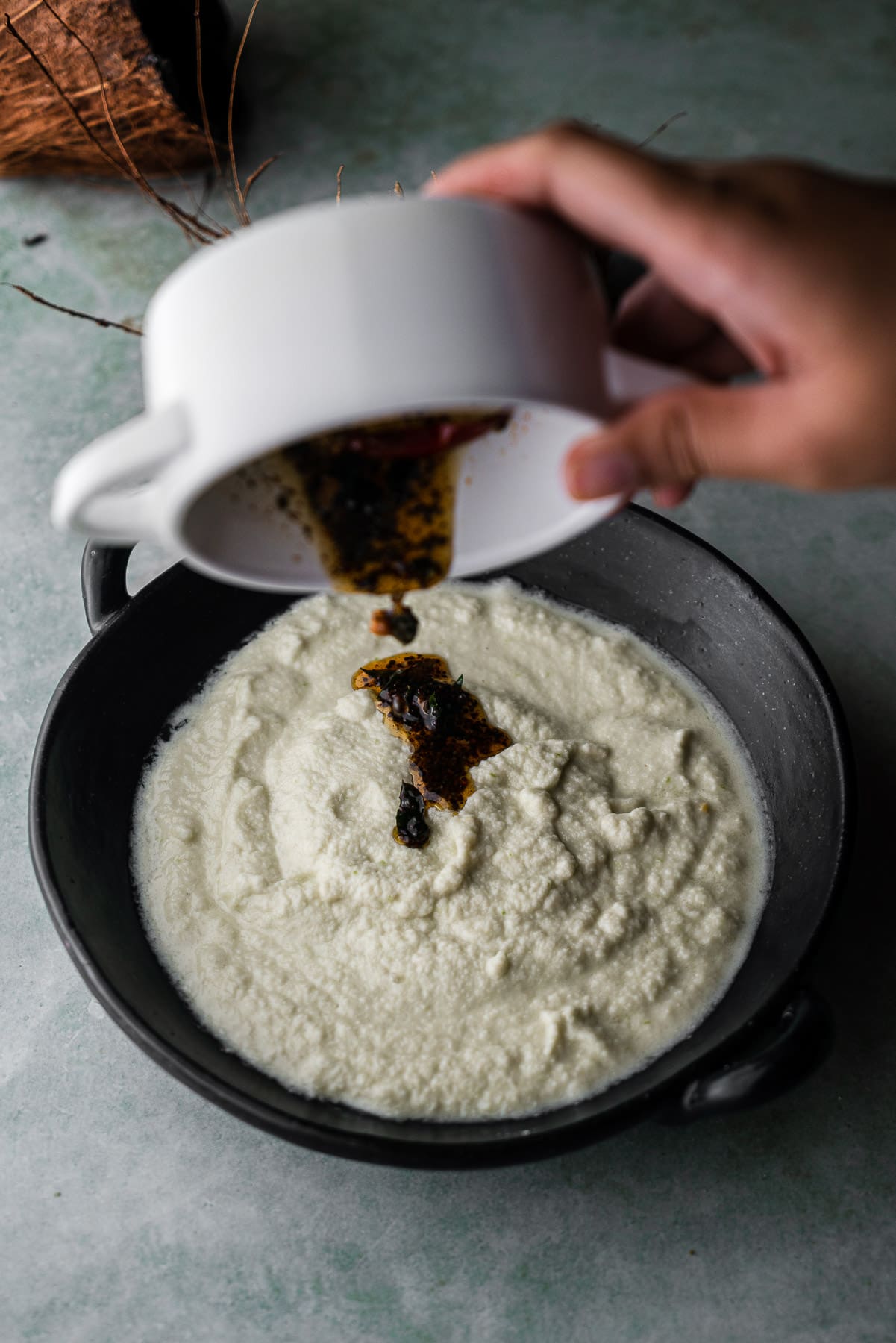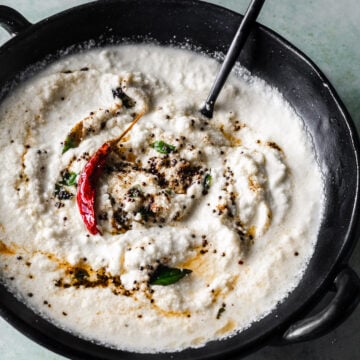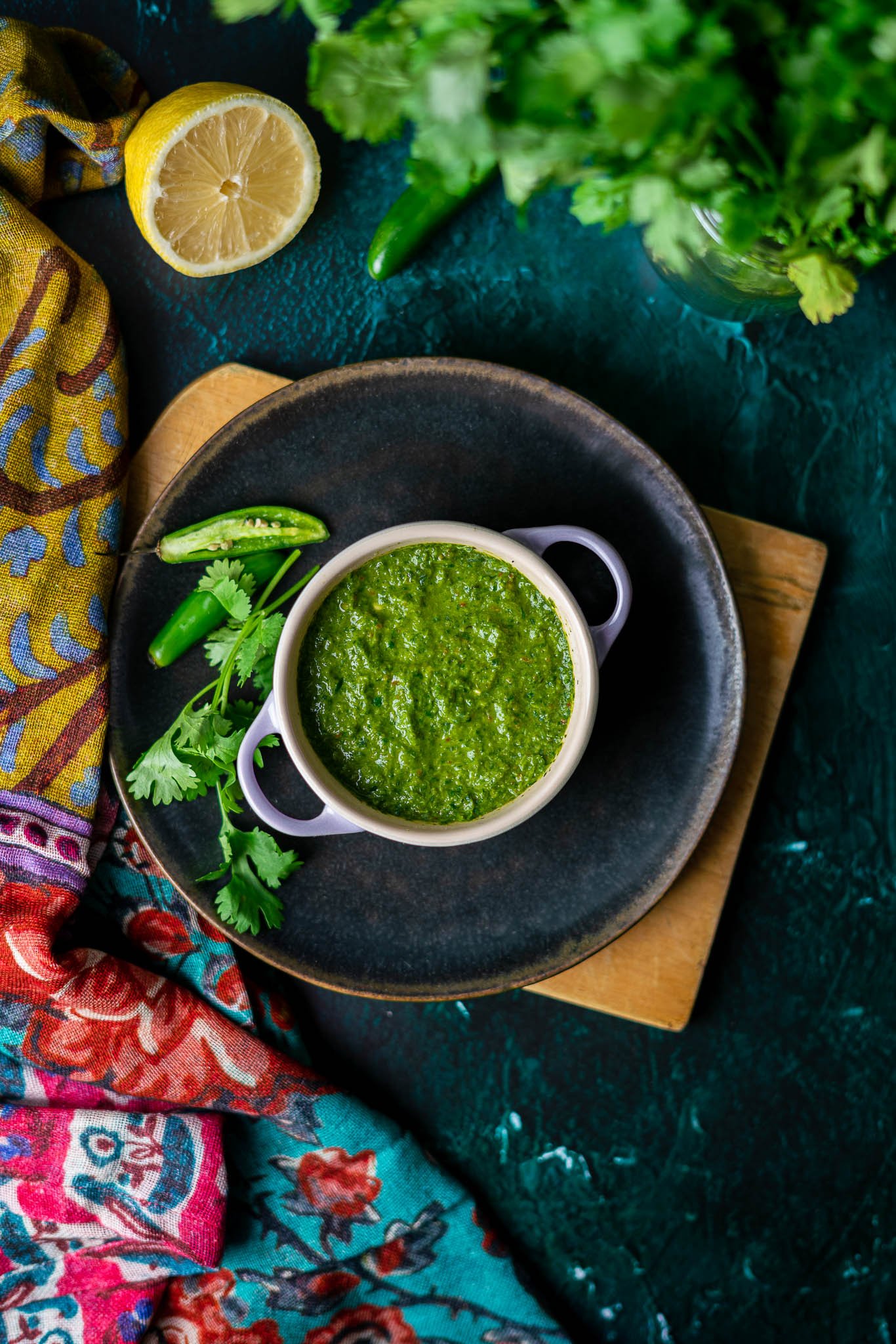Coconut chutney, or nariyal chutney, is a popular traditional South Indian condiment made from fresh brown coconut and chana dal (split chickpeas). It's savory and spicy after being topped with a flavorful tadka of spices and curry leaves. The chutney is served along with breakfast and brunch items like idli, dosa, and uttapam.

I'm super excited to share my mother's coconut chutney recipe!
Chutneys were made weekly in my household. Some households even make chutney fresh on a daily basis, because it's served with absolutely everything.
Coconut chutney is especially popular when we have brown coconuts in the house. They're also called puja coconuts, because they're used for Hindu prayers. Breaking the coconut during puja signifies shedding our outer shells, our ego and negative qualities, in front of God to reveal our pure inner layer.
The coconuts never go to waste! They're snacked on, dried for later use, or more commonly used for coconut chutney. My household is from Delhi, in northern India, so it was always special if we got South Indian cuisine. Dosas and idli came from boxed, readymade mixes but we always had fresh coconut chutney made at home.
Jump to:
What is Coconut Chutney?
Let's start with defining chutney.
Chutney encompasses various forms of sauces or condiments in Indian cuisine. They're used as dips, dressings, spread, marinades, or accompaniments to main dishes, sides, and appetizers. Chutneys are made from a wide variety of ingredients, such as tomatoes, herbs, tamarind, coconut, etc. Some of the most popular chutneys are mango chutney, cilantro-mint chutney, and tamarind date chutney.
Coconut chutney is a traditional South Indian condiment made from a coconut-based paste with chana dal (split chickpea). It's then blended with chilis and some other flavor enhancers. Lastly, it's topped with a spicy tadka made of mustard seeds, chilis, asafoetida, and curry leaves.
Coconut chutney is a staple in South Indian cuisine due to the abundance of fresh coconuts in the south of India. It's the best accompaniment for dosa, idli, vada, uttapam, etc. You may recognize it as the dosa chutney.
There are also several different types and styles of coconut chutney! The popular ones are podina (cilantro) coconut chutney and red coconut chutney which uses red chilis and tamarind.
What is a Tadka?
There's a few ways of working with Indian spices: using them raw, dry roast and grind into a powder, or tempering in oil.
A tadka is blooming, or tempering, spices in fat like ghee or oil in a very small pan, called a tadka pan. It's also known as chhonk or phodni in various regions of India, but is commonly known as tadka to most. Adding spices to hot oil or ghee is a popular technique in Indian cooking that extracts flavor.
You only need a few teaspoons to a few tablespoons of oil based off of the volume of food you're cooking and the spices you're using. The small tadka pan allows the spices to be completely covered by the oil.
The oil used should be at a high smoke point which is why mustard oil, vegetable oil, or ghee are popular picks. It's important to be cognizant of the order of ingredients added into the hot oil to prevent burning.
Ingredients - Notes and Substitutions
While coconut chutney is considered pretty basic in Indian cooking, it does require some specialty ingredients that may not be common to many kitchens.

- Coconut - It's ideal to use fresh brown coconut for chutney. It can be found in most Asian markets or Indian grocers. If not, use frozen grated coconut.
- Chana dal - Chana dal is simply a chickpea with the husk removed and split in half. It can be found at most major grocers or at Indian grocers. Substitute with urad dal.
- Serrano peppers - Substitute with green chilis of preference. Adjust according to preferred heat. I recommend 2 serrano peppers for a mild chutney, and 4 or 5 for a much spicier chutney.
- Curry leaves - It's optional to add curry leaves directly to the coconut-based paste, but I think it adds a lot of extra flavor to the entire chutney. You can also add cilantro instead to make cilantro-coconut chutney. Curry leaves can easily be found fresh at Indian grocers and even come in bundles on Etsy. Dried curry leaves also work.
Tadka Ingredients
For the tadka, use any fat like mustard oil or ghee to roast the spices. Mustard seeds, dried, red chili, asafoetida, and curry leaves create an aromatic, spicy, garlicky mixture oil that's a delicious addition to the coconut.
Asafoetida is also known as hing; it is commonly used in Indian cooking to replace garlic and onion. It smells strongly of garlic and onion and only requires the tiniest pinch. Some people say Pure Indian Foods has the best hing they've ever tasted. Substitute with ⅛ teaspoon of garlic powder and ⅛ teaspoon of onion powder.
How to Open a Fresh Coconut
To open a brown coconut, start by removing the husk. Locate the three holes at the bottom of the coconut. Jam a screwdriver into a hole, and pour out the coconut water into a glass. Save this to drink or add to smoothies, curries, etc.
Hit the coconut shell in the middle with a hammer until it cracks. Continue to hit the coconut around the middle until it breaks open. Remove the coconut meat from both halves and peel off any brown bits from the shell. Rinse the coconut meat so it's ready for chutney.
How to make Coconut Chutney
There's two parts to making coconut chutney - making the coconut-based chutney and then tempering the spices.
1. Roast and Blend the Coconut and Dal

Start by roasting the chana dal in neutral oil until it's golden brown. Drain the oil from the dal and transfer it to a blender.
Cut the fresh coconut into smaller chunks and add it into the blender with the chana dal. Grind the coconut and chana dal together as much as possible. Scrape the sides down with a spatula, and then add a little water as necessary to run the blender until the coconut meat and chana dal turn into a paste.
Then, add the serrano peppers, ginger, salt, curry leaves, and lemon juice and continue running the blender. Add water from the top of the blender until the paste starts to run into a smooth thick chutney consistency. It shouldn't be watery at all. It'll still be gritty from the coconut. Transfer the coconut chutney to a bowl or wide-mouth jar.
Tadka
Add oil to a tadka pan or a very small pot / pan and heat it on low to medium. The coconut chutney doesn't require too much oil since the coconut releases it's own oils.
Pro Tip: Only use 1 teaspoon to ½ tablespoon depending on how much coconut chutney resulted from the previous step. If you're using a small pot or pan, let the oil pool to one side and only add the spices directly into the oil.
Remove the stem from the red chili and break it in half. Once the oil starts to shimmer, add the mustard seeds and chili. After the mustard seeds start popping, add the curry leaves and asafoetida. Stir the oil with a small spatula or spoon.
Pro Tip: Be very careful! The moisture in the curry leaves will cause the oil to start sputtering. Lift the tadka pan from the stove as necessary to control the heat.

Continue to roast until the curry leaves get crispy. The oil should be very aromatic. Remove the tadka pan from heat and pour it over the coconut chutney. Give the chutney a stir, and it's ready to serve.
Serving and Storing Suggestions
Coconut chutney is a popular condiment for most items in South Indian cuisine. It's appropriate for breakfast, appetizers, and main dishes all the same.
Serve it popular breakfast items like idli, dosa, uttapam, or vada. Or serve it with savory dishes like pakoras or in sandwiches. It would be perfect with these Dosa Waffles!
Store coconut chutney in the fridge for up to 7-10 days. Alternatively, freeze it in an ice cube tray and transfer them to a freezer bag for up to 3 months.

More Chutneys and Achaars
Recipe
Want to Save This Recipe?
Thinking about making this recipe? Enter your email and I'll send it straight to your inbox to save for later. Plus, get new recipe inspiration from me every week!
By submitting this form, you consent to receive emails from Masala and Chai.

Coconut Chutney
Ingredients
- 10 ounces coconut meat
- 2 tablespoon chana dal, roasted
- 2-4 serrano peppers, to preference
- ½ teaspoon salt
- ½ tablespoon ginger, minced
- ½ cup water
- ¼ cup lemon juice
- ½ sprig curry leaves, (optional)
Tadka
- ½ tablespoon oil
- ¼ teaspoon mustard seeds
- 1 red chili, dried
- pinch asafoetida
- 1 sprig curry leaves
Instructions
- If the chana dal is unroasted, heat some oil in a small pan on medium heat. Once hot, add the chana dal and roast until it's golden brown. Strain out the oil and add the chana dal to the blender.
- Cut the coconut meat into smaller chunks and add it to the blender. Grind the coconut and chana dal together as much as possible until they start to break down into smaller parts. Add a bit of water and scrape down any bits and pieces as needed to get the blender going.
- Then, add the serrano peppers, ginger, salt, curry leaves, and lemon juice. Continue to run the blender, adding water from the top until the blender runs smooth. The chutney will be a bit gritty but it should be thick and not watery. Transfer the chutney to a bowl.
- Heat a tadka pan on low to medium heat. Remove the stem of the red chili and break it in half. Add the mustard seeds and red chili. Cook until the mustard seeds start to pop, then add the asafoetida and curry leaves. Once the curry leaves turn crisp, remove the tadka from heat.
- Pour the tadka on top of the coconut chutney. Mix the chutney together with a spoon. Serve as an accompaniment to dosa, idli, etc.
Notes
- This recipe results in about 3 cups of coconut chutney.
- Omit the asafoetida for gluten-free chutney.
- Store coconut chutney in the fridge for up to 7-10 days. Alternatively, freeze it in an ice cube tray and transfer them to a freezer bag for up to 3 months.




Leave a Reply